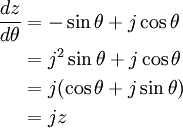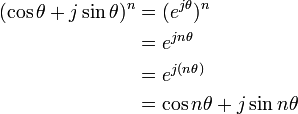A-level Mathematics/MEI/FP2/Complex Numbers
< A-level Mathematics < MEI < FP2Modulus-argument form
Polar form of a complex number
It is possible to express complex numbers in polar form. The complex number z in the diagram below can be described by the length r and the angle  of its position vector in the Argand diagram.
of its position vector in the Argand diagram.
[Argand diagram]
The distance r is the modulus of z,  . The angle
. The angle  is measured from the positive real axis and is taken anticlockwise. Adding any whole multiple of
is measured from the positive real axis and is taken anticlockwise. Adding any whole multiple of  however, would give the same vector so a complex number's principal argument,
however, would give the same vector so a complex number's principal argument,  , is where
, is where  . The following examples demonstrate this in each quadrant.
. The following examples demonstrate this in each quadrant.
The following Argand diagram shows the complex number. [Argand diagram]

This Argand diagram shows the complex number.
This Argand diagram shows the complex number.
This Argand diagram shows the complex number.
When we have a complex number  in polar form
in polar form  we can use
we can use  and
and
 to write it in the form:
to write it in the form:  . This is the modulus-argument form for complex numbers.
. This is the modulus-argument form for complex numbers.
Multiplication and division
The polar form of complex numbers can provide a geometrical interpretation of the multiplication and division of complex numbers.
Multiplication
Take two complex numbers in polar form,


and then multiply them together,

The result is a complex number with a modulus of  and an argument of
and an argument of  . This means that:
. This means that:


Division
Dividing two complex number  and
and  in polar form:
in polar form:


⇒ 
Multiply numerator and denominator by  .
.

Then, use distribution to simplify.

Here, factorize by  in the numerator and cancel out terms in the denominator.
Note that
in the numerator and cancel out terms in the denominator.
Note that  .
.


Apply the formulas for the cosine of the difference of two angles and for the sine of the difference of two angles:
 .
.
De Moivre's theorem
Using the multiplication rules we can see that if

then


De Moivre's theorem states that this holds true for any integer power. So,

Complex exponents
Definition
If we let  we can then differentiate z with respect to
we can then differentiate z with respect to  .
.

The general solution to the differential equation  is
is  .
.
This means that 
By putting  as 0 we get:
as 0 we get:

So the general definition can be made:

For a complex number  , calculating
, calculating  can be done:
can be done:

Proof of de Moivre's theorem
We can now give an alternative proof of de Moivre's theorem for any rational value of n:

Summations
deMoivre's therom can come in handy for finding simple expressions for infinite series. This usually involves a series multiple angles, cosrθ, as in this next example:
Infinite series are defined by:


In order to find either the sum of C or the sum of S (or both!) you need to add C to jS:
 Which using deMoivre's theorem can be written as:
Which using deMoivre's theorem can be written as:

It is easier to work with now using the form e^jθ:

and you should be able to see the pattern, that the factor is negative 1/2 to the power of n-1 (the negative being alternately to even then odd powers is what makes it flip between + and -) and the power of e (the number in front of θ in our original equations) is equal to 3(n-1)jθ.

This is a geometric series, with a=
Complex roots
The roots of unity
The fundamental theorem of algebra states that a polynomial of degree n should have exactly n (complex) roots. This means that the simple equation  has n roots.
has n roots.
Let's take a look at  . This has two roots, 1 and -1. These can be plotted on an Argand diagram:
. This has two roots, 1 and -1. These can be plotted on an Argand diagram:
[Argand diagram]
Consider  , from the above stated property, we know this equation has three roots. One of these is easily seen to be 1, for the others we rewrite the equation as
, from the above stated property, we know this equation has three roots. One of these is easily seen to be 1, for the others we rewrite the equation as  and use the factor theorem to obtain
and use the factor theorem to obtain  . From this, we can solve
. From this, we can solve  by completing the square on z so that we have
by completing the square on z so that we have  . Solving for z you obtain
. Solving for z you obtain  . We have now found the three roots of unity of
. We have now found the three roots of unity of  , they are
, they are  ,
,  and
and 
Solving an equation of the form 
We know  has six roots, one of which is 1.
has six roots, one of which is 1.
We can rewrite this equation replacing the number 1 with  since 1 can be represented in polar form as having a modulus of 1 and an argument which is an integer multiple of
since 1 can be represented in polar form as having a modulus of 1 and an argument which is an integer multiple of  .
.

Now by raising is side to the power of 1/6:

To find all six roots we just change k, starting at 0 and going up to 5:
